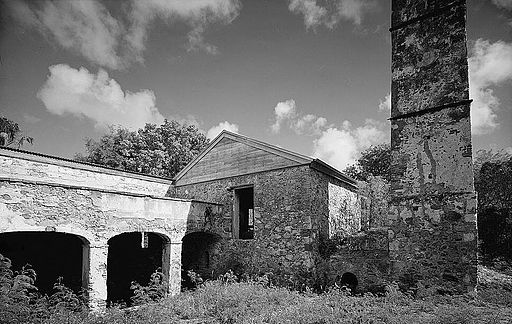St. John has the distinction of having had two steam-powered sugar factories. One was located in the center of the island at Estate Adrian. The other was at Reef Bay.
Reef Bay is a large shallow V-shaped bay that is protected by a lot of reef, hence its name. This is a poor composite of three photos of mine. Yet still it gives a vague impression of what it looks and feels like.
Here's a better picture of it taken by Galen S. Swint.
There are three ways into Reef Bay: by boat, by hiking over the hill from Lamashur, which is on the other side of those white cliffs, or by picking up the trail-head on Center Line Road and walking down a three mile trail. It's a fabulous walk that takes you from lush tropic forest down to tropical desert. However the hike out is a brutal, long, never ending climb.
The first ruins along the trail are the remains of Josie Gut Plantation, built in the early 18th century. Farther down is Estate Par Force. Between 1721-24 it was parceled out into four separate estates, but by 1765 they had been combine into one estate called Par Force. Besides sugarcane, the rich valley was cultivated with coconut palms, bananas, fruit and citrus trees. Cattle and sheep grazed the hillsides.
In 1830, a new sugar factory was built near the beach and Par Force was abandoned. This is a picture of the ruins taken sometime after 1933. It's what my mother saw in1934 when she, her mother and one of her brothers hiked in. (As recorded in my grandmother's journal.)

This picture of mine was taken about ten years ago.
After the end of slavery in 1848 sugar production rapidly declined and in 1855 the Reef Bay factory was converted to steam power.
The steam engine was built in Glasgow, Scotland.
In 1908 a 15 year old boy was crushed in the machinery. After that it was hard to find people who would work there because they thought the factory was haunted.
In 1916 the Reef Bay factory shut down. It was the last sugar factory to closed, and brought to a final end the 200 year sugar plantation era on St. John.
For a more detailed account of the history of Reef Bay check out this excerpt from Off the Beaten Track by Gerald Singer. In it there are more pictures of the machinery used for crushing the cane and boiling the juice.




It looks beautiful. I love the photographs!
ReplyDeleteThat bay is soooo beautiful. After reading your posts for so long, I have to admit, retiring there sounds like it's going on my bucket list.
ReplyDeleteBeautiful. I suddenly have a craving for sugarcane now! LOL.
ReplyDeleteAbsolutely fascinating (and gorgeous, too)!
ReplyDeleteI hate walking, but I'd do it for that view.
ReplyDeleteIs it still haunted?
ReplyDeleteBeautiful. So beautiful! I love the factory history too. YUCK about the boy being crushed, but kinda cool to think of it being haunted.
ReplyDeleteLovely. Lovely. Lovely. It must have inspired Hamilton to great thinking.
ReplyDeleteThanks for telling me he was reared on St. Croix. I didn't know that, or I'd forgotten!
That bay is so beautiful. I can't imagine being on a beach like that - with no else around. Amazing!
ReplyDeleteAnd the sugar factory pictures are fascinating. Is that machinery still there? Or was it when you took the exterior pictures about 10years ago?
The first two photos are so beautiful - it looks like paradise!
ReplyDeleteYes, Suzanne, the machinery is still there!
ReplyDeleteNumber one, I adore old buildings. There's something magical about them. Number two, beautiful pictures!
ReplyDeleteBeautiful, as always.
ReplyDeleteBish, have you ever thought of writing a nonfiction children's books about the Islands? Or a storybook?
Those are some really nice pictures of the bay. It's cool to see pictures of what's left of the old properties.
ReplyDeleteThat story about the boys death makes me think about some of the stuff I've read in historical fiction that deals with slave plantations.
Lovely and fascinating. Thanks for sharing
ReplyDeleteLove the photos and history. It's so interesting that people refused to work in the factory because they thought it was haunted.
ReplyDelete